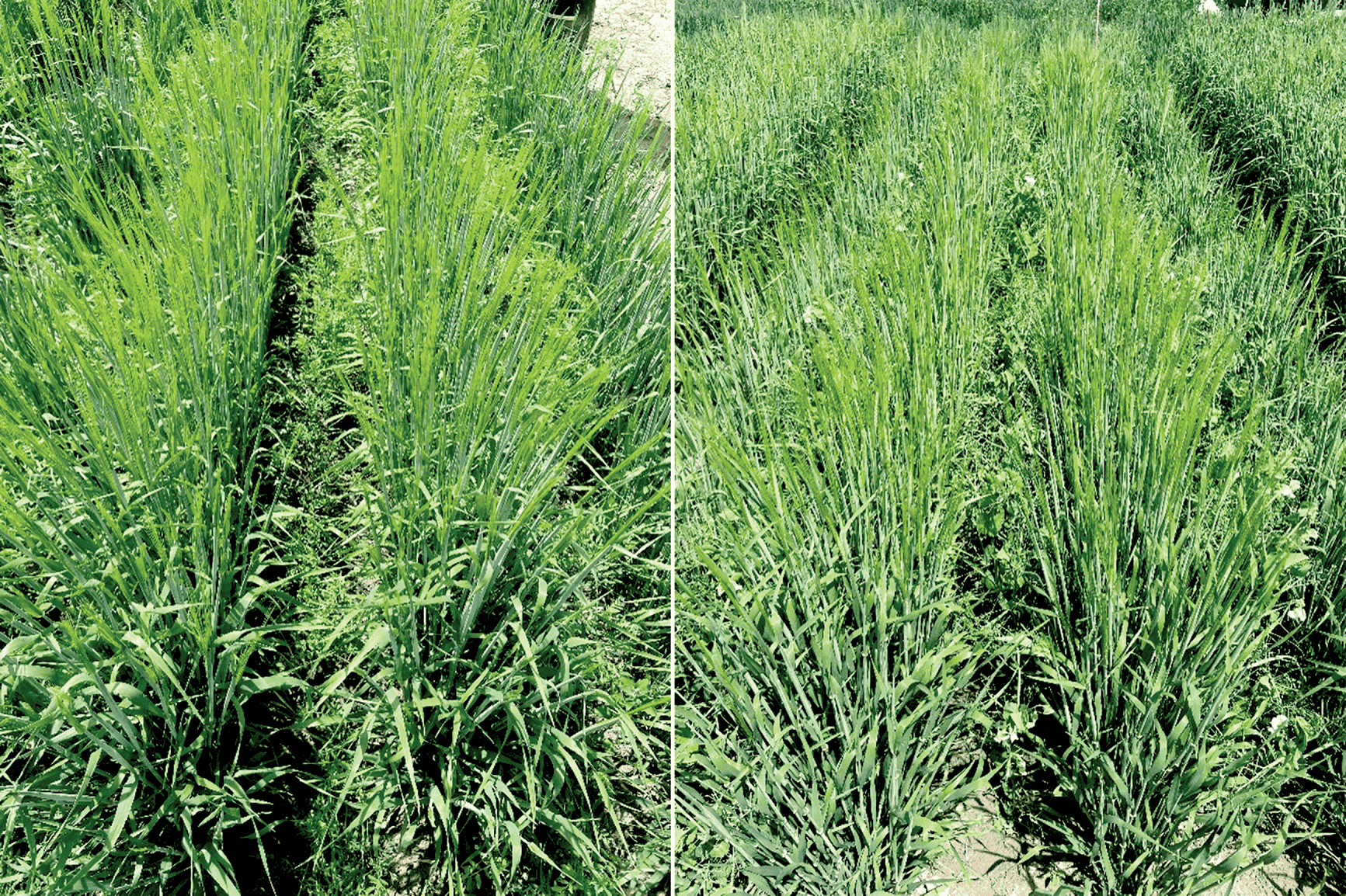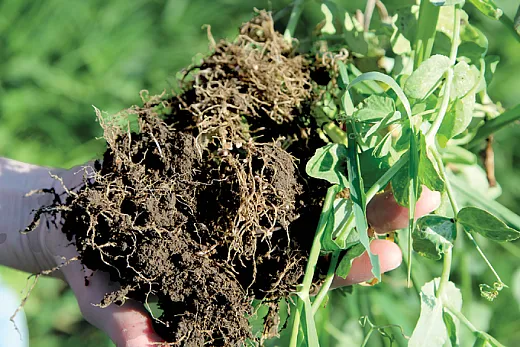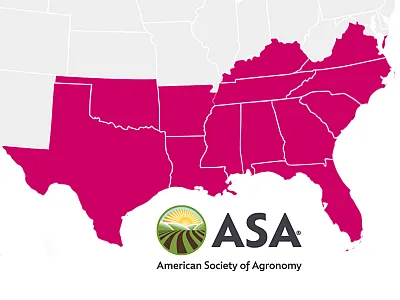Barley–Pulse Intercropping Improves Resource Use Efficiency and Soil Health


Semiarid regions in southern Idaho receive a small amount of annual precipitation (e.g., 9–12 inches), and crop options are very limited in dryland farming without supplemental irrigation. To diversify cropping systems, growers can incorporate crops with lower water requirements through rotations and intercropping. Field trials were conducted to evaluate crop yield and soil health in barley–pulse intercrops under full and deficit irrigation with no supplemental N fertilizers. Earn 0.5 CEUs in Soil & Water Management by reading this article and taking the quiz.
Semiarid regions in southern Idaho receive a small amount of annual precipitation (e.g., 9–12 inches), and crop options are very limited in dryland farming without supplemental irrigation. To diversify cropping systems, growers can incorporate crops with lower water requirements through rotations and intercropping. Pulse crops (e.g., lentil, pea, and chickpea) require less water (smaller seasonal crop evapotranspiration) than small grains. In intercropping systems of pulses and small grains, pulse crops could be forced to provide more nitrogen (N) from symbiotic N fixation and increase overall N availability to small grains (Hauggaard‐Nielsen et al., 2009). We are conducting field trials to evaluate crop yield and soil health in barley–pulse intercrops under full and deficit irrigation with no supplemental N fertilizers.
Crop Yield and Water Use Efficiency
In 2020, barley yield from barley–lentil intercropping was not different from monocropping barley or barley–pea intercropping, but yield of monocropping barley was greater than barley–pea intercropping regardless of irrigation treatments (Table 1). Under full irrigation, pea yield was greater than lentil in intercropping systems, but the yield did not differ significantly under deficit irrigation. In 2021, barley yield was not significantly affected by intercropping systems or irrigation treatments (Table 1). Under full irrigation, pea yield was greater than lentil in intercropping systems, but the yield did not differ under deficit irrigation. In 2020, barley‐based water use efficiency under deficit irrigation was greater than full irrigation, but there were no difference between irrigation treatments or cropping systems in 2021. The very different yield and water use efficiency between 2020 and 2021 were due to unfavorable weather conditions and lower soil N in 2021.

The lack of difference in barley yield between monocropping and intercropping suggests that individual barley plants in intercropping systems can compensate for the low plant density by developing more tillers per plant compared with monoculture barley. The lack of difference was more obvious under deficit irrigation and in the drier year of 2021. Cereal–pulse intercropping can optimize the use of soil moisture for crop growth and development by complimentary root growth associated with enhanced water and nutrient uptake (Bedoussac & Justes, 2010; Chen et al., 2018; Ren et al., 2017; Stomph et al., 2020; Pelzer et al., 2012). Intercropping cereals with legumes is thus a strategy to synchronize crop N demand with N availability by N fixation and improve water and nutrient use efficiencies of the whole system.
In 2020, rainfall during the growing season was 2.6 inches, and irrigation was 11.1 inches for full irrigation and 5.6 inches for deficit irrigation. In 2021, rainfall during the growing season was 0.4 inches, and irrigation was 17.2 inches for full irrigation and 9.2 inches for deficit irrigation. The water input of the deficit irrigation treatment is similar to the water availability of dryland farms in southern Idaho. Water use efficiency was calculated by barley grain yield divided by total water input during the growing season (i.e., rainfall and irrigation).
| Grain Yield |
| ||||
|---|---|---|---|---|---|---|
Cropping system | 2020 | 2021 | Barley-based water use efficiency | |||
Barley | Pulse | Barley | Pulse | 2020 | 2021 | |
Full irrigation | ||||||
Barley | 6120 | — | 2685 | — | 0.110 | 0.030 |
Barley+Lentil | 5282 | 228 | 1865 | 383 | 0.096 | 0.026 |
Barley+Pea | 4675 | 636 | 2070 | 874 | 0.084 | 0.029 |
Deficit irrigation | ||||||
Barley | 4800 | — | 1775 | — | 0.146 | 0.045 |
Barley+Lentil | 4871 | 104 | 1419 | 191 | 0.148 | 0.036 |
Barley+Pea | 4193 | 332 | 1454 | 201 | 0.127 | 0.037 |
Soil Health
Improving soil health is recommended for increasing the long‐term sustainability of cropping systems as well as having near‐term benefits to plant growth by improving access to soil water and nutrients. We chose permanganate oxidizable carbon (POx‐C) as a measurement of soil health for the experimental setup described previously. POx‐C quantifies carbon available to microbes below ground that can help in nutrient release or, in the case of mycorrhiza, water availability. We quantified POx‐C for the two years integrating over 0‐ to 1‐ and 1‐ to 3‐ft depths for both the deficit and full irrigation treatments and all the cropping treatments.
We observed the largest values of POx‐C in the intercropping treatment under full irrigation during the second year. The largest declines in this soil carbon fraction also occurred with intercropping under deficit irrigation, particularly in the first year of the experiment. The overall dynamics show an overall buildup in carbon between 2020 and 2021, but an interesting result is the buildup of carbon in the lower depths. The complementary utilization of growing space by pulse–cereal intercropping treatment led to a relatively rapid buildup of carbon with depth.
The results depict only two years of the trials, but the indications are promising. We are particularly interested in learning how carbon accrual rates might differ between years. For example, gains in carbon were observed across all treatments, but the barley monocrop incremental gain appeared to slow in the second year of the experiment. Interestingly, the carbon concentration in the intercropping plots with deficit irrigation was similar to monocropping barley, which may have resulted from the overlapping root distributions of the crops. Data from 2022 and 2023 may highlight the role of seasonal variation and whether or not soil carbon continues to build in the intercropping treatment.
| Cropping system | 2020 (ΔPOx-C ppm) | 2021 (ΔPOx-C ppm) | ||
|---|---|---|---|---|
| 0–1 ft | 1–3 ft | 0–1 ft | 1–3 ft | |
ΔPOx-C ppm soil | ||||
Full irrigation | ||||
Barley | 33.4 | 16.6 | 23.6 | 25.9 |
Barley+Lentil | –23.3 | 7.1 | 33.4 | 49.3 |
Barley+Pea | 13.5 | 15.3 | 44.7 | 36.1 |
Deficit irrigation | ||||
Barley | 4.6 | 10.1 | 33.6 | 25.3 |
Barley+Lentil | –11.3 | –9.8 | 30.6 | 16.9 |
Barley+Pea | –22.1 | –10.3 | 34.4 | 25.2 |
Conclusion
Barley–pulse intercropping systems benefit barley yield more at 50/50 of recommended seeding rates of individual species. Barley grain yield did not differ significantly between barley monocropping and barley–pulse intercropping, especially under deficit irrigation, suggesting barley–pulse intercropping systems could be suitable for areas of limited irrigation supplies or dryland farming. Ultimately, the increases in available carbon we observed here are harbingers of improved soil health more generally. Soil organic matter and carbon serve to encourage greater microbial diversity and function, and organic matter can bind nutrients and absorb water for plant and microbial production. Therefore, barley–pulse intercropping increases plant diversity, which can result in a more diverse microbial community and healthier soil, and the microbial networks can interconnect plants, leading to enhanced available nutrients and soil moisture.
Acknowledgments
The project is funded by the USDA-ARS Pulse Crop Health Initiative and the Idaho Barley Commission.
References
Bedoussac L., & Justes, E. (2010). Dynamic analysis of competition and complementarity for light and N use to understand the yield and the protein content of a durum wheat–winter pea intercrop. Plant and Soil, 330, 37–54.
Chen, G., Kong, X., Gan, Y., Zhang, R., Feng, F., Yu, A., … & Chai, Q. (2018). Enhancing the systems productivity and water use efficiency through coordinated soil water sharing and compensation in strip intercropping. Scientific Reports, 8, 10494.
Hauggaard‐Nielsen H., Gooding, M., Ambus, P., Corre‐Hellou, G., Crozat, Y., Dahlmann, C., & Jensen, E.S. (2009). Pea–barley intercropping for efficient symbiotic N2‐fixation, soil N acquisition and use of other nutrients in European organic cropping systems. Field Crops Research, 113(1): 64–71.
Pelzer, E., Bazot, M., Makowski, D., Corre‐Hellou, G., Naudin, C., Al Rifaï, M., … & Jeuffroy, M.‐H. (2012). Pea‐wheat intercrops in low‐input conditions combine high economic performances and low environmental impacts. European Journal of Agronomy, 40, 39–53.
Ren, Y., Wang, X., Zhang, S., Palta, J.A., & Chen, Y. (2017). Influence of spatial arrangement in maize–soybean intercropping on root growth and water use efficiency. Plant and Soil, 415, 131–144.
Stomph, T., Dordas, C., Baranger, A., de Rijk, J., Dong, B., Evers J, … & van der Werf, W. (2020). Designing intercrops for high yield, yield stability and efficient use of resources: Are there principles? Advances in Agronomy, 160(1), 1–50.
Self-Study CEU Quiz
Earn 0.5 CEUs in Soil & Water Management by taking the quiz. For your convenience, the quiz is printed below. The CEU can be purchased individually, or you can access as part of your Online Classroom Subscription.
- Pulse crops like pea require more water than small grains like barley.
- True.
- False.
- In Table 1, pea yield was _____ than lentil in intercropping systems under deficit irrigation in 2021.
- almost two times less
- almost three times less
- greater
- not significantly different
- What does permanganate oxidizable carbon (POx-C) quantify?
- Carbon available to microbes above ground that can help in water availability.
- Carbon available to microbes above ground that can help in nutrient release.
- Carbon available to microbes below ground that can help in nutrient release or water availability.
- Oxygen available to microbes below ground that can help in nutrient release or water availability.
- In Table 2, gains in carbon were observed across which treatments?
- Lentil and pea under full irrigation.
- Lentil and pea under deficit irrigation.
- Barley under both full and deficit irrigation.
- All treatments.
- At what soil depths did the authors measure POx-C?
- 0 to 1 and 1 to 3 ft.
- 0 to 1 and 1 to 2 ft.
- Only 0 to 1 ft.
- Only 1 to 3 ft.
Text © . The authors. CC BY-NC-ND 4.0. Except where otherwise noted, images are subject to copyright. Any reuse without express permission from the copyright owner is prohibited.









